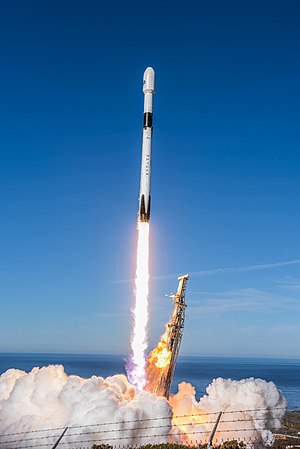Stupeň B1063 Falconu 9
 Start s družicí Sentinel-6A. | |
| Použití | první stupeň orbitální rakety |
|---|---|
| Země původu | USA |
| Typ | první stupeň Falconu 9 Block 5 |
| Výrobce | SpaceX |
| Sériové číslo | B1063 |
| První let | 21. listopadu 2020 |
| Poslední let | 26. května 2021 |
| Počet letů | 2 |
| Status | aktivní |
Stupeň B1063 Falconu 9 je první stupeň rakety Falcon 9, vyráběné společností SpaceX, jedná se o osmnáctý vyrobený exemplář verze Block 5. Dne 24. srpna 2020 byl se stupněm proveden statický zažeh na základně McGregor. Poprvé letěl na misi s družicí Sentinel 6A z Vandenbergovy základny v Kalifornii.
V polovině března byl stupeň přepraven z Kalifornie na Floridu s několika odmontovanými motory. Druhý start tohoto stupně a zároveň první z Floridy byl proveden 26. května 2021, kdy byly vyneseny družice Starlink.
Přehled letů
| Číslo použití | Datum startu (UTC) | Let číslo | Náklad | Start | Místo startu | Přistání | Místo přistání | Poznámky |
|---|---|---|---|---|---|---|---|---|
| 1 | 21. listopadu 2020 | 99 | Sentinel 6A |  | VAFB |  | LZ-4 | |
| 2 | 26. května 2021 | 119 | Starlink v1-L28 | CCAFS | JRTI |
Média použitá na této stránce
The SpaceX Falcon 9 rocket carrying the Sentinel-6 Michael Freilich spacecraft lifts off from Space Launch Complex 4 at Vandenberg Air Force Base in California, Nov. 21, 2020, at 9:17 a.m. PST (12:17 p.m. EST). The Sentinel-6/Jason-CS (Continuity of Service) mission consists of the Sentinel-6 Michael Freilich satellite, which will be followed by its twin, the Sentinel-6B satellite, in 2025. The Sentinel-6/Jason-CS mission is part of Copernicus, the European Union’s Earth observation program, managed by the European Commission. Continuing the legacy of the Jason series missions, Sentinel-6/Jason-CS will extend the records of sea level into their fourth decade, collecting accurate measurements of sea surface height for more than 90% of the world’s oceans,and providing crucial information for operational oceanography, marine meteorology, and climate studies. NASA’s Launch Services Program at Kennedy Space Center was responsible for launch management.
Members at Vandenberg Air Force Base launched the Sentinel-6 Michael Freilich satellite Saturday, Nov. 21, 2020, at 9:17 a.m., from Vandenberg Air Force Base, Calif. The Sentinel-6 is the first of two identical satellites to head into Earth orbit five years apart to continue sea level observations for at least the next decade. The 30th Space Wing’s primary responsibilities include maintaining and operating the Western Range, providing mission assurance, safeguarding the public and ensuring minimal environmental impact so we can provide services, facilities and range safety control for the execution of Department of Defense, civilian and commercial launches.
The SpaceX Falcon 9 first stage booster lands at Space Launch Complex 4 at Vandenberg Air Force Base in California after launching the Sentinel-6 Michael Freilich spacecraft on Nov. 21, 2020, at 9:17 a.m. PST (12:17 p.m. EST). The Sentinel-6/Jason-CS (Continuity of Service) mission consists of the Sentinel-6 Michael Freilich satellite, which will be followed by its twin, the Sentinel-6B satellite, in 2025. The Sentinel-6/Jason-CS mission is part of Copernicus, the European Union’s Earth observation program, managed by the European Commission. Continuing the legacy of the Jason series missions, Sentinel-6/Jason-CS will extend the records of sea level into their fourth decade, collecting accurate measurements of sea surface height for more than 90% of the world’s oceans,and providing crucial information for operational oceanography, marine meteorology, and climate studies. NASA’s Launch Services Program at Kennedy Space Center was responsible for launch management.


